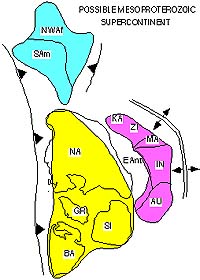
 |
Freethought & Rationalism ArchiveThe archives are read only. |
|
|
#1 |
|
Contributor
Join Date: Jul 2000
Location: Lebanon, OR, USA
Posts: 16,829
|
The way that continents have sometimes been described; there is evidence of an abundance of continental drifting over the past few billion years of the Earth's history, though the evidence gets more difficult to interpret the farther back one goes.
This is an answer to one criticism of the continental-drift concept often made in years past, that continental drift apparently started only with the breakup of Pangaea (Pangea) about 200 million years ago, which is not much of the Earth's history. However, some young-earth creationists support this Pangaea-breakup-only continental drift; they believe that Pangaea had broken up at a superfast rate after Noah's Flood. But the evidence for pre-Pangaea drift is as strong as that for post-Pangaea drift. Pangaea itself formed from some colliding continents; these collisions formed the Appalachian and the Ural Mountains, in the fashion that the collision of India and Asia has produced the Himalaya Mountains. Some good places to go for continental-drift reconstructions:
There is even evidence for pre-Pangaea supercontinents, the most recent of which have been named Pannotia and Rodinia. Rodinia had existed between 1100 and 750 million years, and Pannotia had briefly formed about 650 million years ago. Both Steven Dutch and Ian Dalziel give reconstructions of Rodinia; notice that Laurentia (North America) is in the middle. As Rodinia broke apart, Laurentia developed <a href="http://quake.ualr.edu/public/reelfoot.htm" target="_blank">the Reelfoot Rift</a> from Illinois to the Gulf of Mexico, but that rift eventually failed. But that rift is not completely dead; the New Madrid earthquakes of 1811-12 had occurred inside of it. And before Rodinia? <a href="http://news.bbc.co.uk/hi/english/sci/tech/newsid_1892000/1892869.stm" target="_blank">This recent story</a> suggests that there was an even older one, one named Columbia, that existed between 1.8 and 1.5 billion years ago. And supercontinents before Columbia will be even more difficult to identify, though there may have been an additional one at the beginning of the Proterozoic, about 2.3 billion years ago. But before then, in the Archean, the continents were very small blocks, a few hundred km in size, which would collide and stick to each other, forming the bigger continents of later times. |
|
|
|
|
#2 |
|
Contributor
Join Date: Jul 2000
Location: Lebanon, OR, USA
Posts: 16,829
|
Here's a <a href="http://www.spacedaily.com/news/tectonics-02b.html" target="_blank">somewhat better story</a> on the proposed supercontinent Columbia.
Here is a reconstruction of Rodinia from <a href="http://www.uwgb.edu/dutchs/platetec/plhist94.htm" target="_blank">Steven Dutch's site</a>: And here is Columbia: 
|
|
|
|
|
#3 |
|
Veteran Member
Join Date: Oct 2001
Location: Alberta
Posts: 1,049
|
David Grinspoon in "Venus Revealed" described continents as the scum (or froth) of plate techtonics. Somewhat analagous to small but buoyant bits of froth on the ocean that gather on the shoreline.
|
|
|
| Thread Tools | Search this Thread |
|